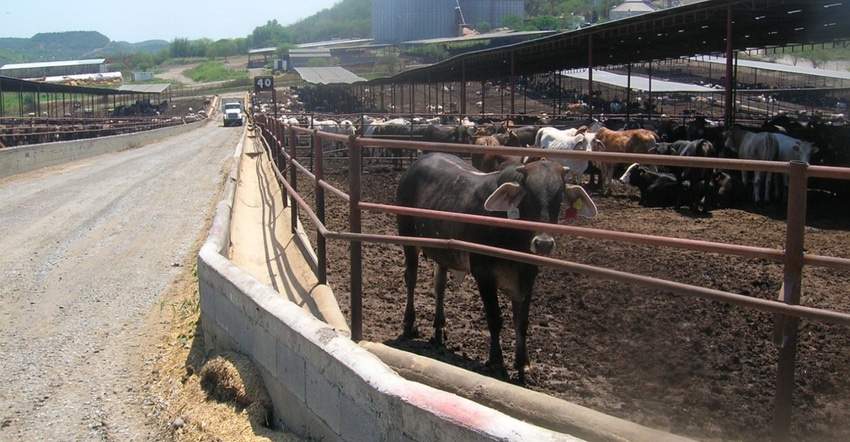August 28, 2019

By Steve Boyles
Feed bunk management plays an important role in both animal performance and preventing acidosis in the feedyard.
One part of feed bunk management is estimating how much feed cattle will eat. Factors such as cattle size, weight, breed, ration type, weather and health must be considered. Previous history of feed intake for a pen of cattle can help in estimations.
How much work do you want to put into gaining an estimate of how your steer or a group of cattle are eating?
Estimates can be made prior to a morning feeding — if you are providing a morning feeding — with two additional observations made during the day. A common method is making one observation during consumption of the first feed, and a second one in the afternoon prior to a feeding. Feed should not be increased by more than 10% from one feeding to the next. Decreases of more than 10% may be justified, too, for cattle to clean the bunks. Generally, feed calls should not be decreased in the afternoon.
Consider developing a sheet for monitoring and tracking your feeding. A bunk sheet could contain the following information:
1. Pen number
2. Head count
3. In weight
4. Current weight
5. Days on feed
6. Day on ration
7. Indication of slick bunks
8. Indication of when bunks last cleaned
9. Pen condition (dry, muddy, etc.)
The following table allows the feeder to estimate actual feed consumption and track trends in intake. By keeping at least four days of records available, one can account for the delayed response in cattle behavior to a feed change.

Feed intake estimates, or feed calls, are made prior to feeding, using information on consumption and bunk scores from previous days. The next table shows an example for four pens that gives a feel for how feed calls (pounds of feed per pen), used in conjunction with bunk scores, might be interpreted.

• Pen A. Intake erratic
• Pen B. Intake consistent
• Pen C. Intake consistent to steady increase
• Pen D. Intake on steady increase
Some of the factors that affect feed call decisions include cattle aggressiveness and weather. At the time of feeding, 25% of the cattle should be lined up ready to eat, 50% should be standing and working their way to the bunk, and 25% should be getting up and stretching. There may be time when the bunk is empty (slick), but because the cattle are not aggressive, you wait to increase them.
Weather can affect feed intake. Heat reduces appetite. This may cause you to reduce the amount fed or alter when cattle get most of their feed (afternoon versus morning feeding). Rain can affect feed palatability, especially in warm weather. Cattle should not be forced to consume stale feed; it should be removed from the bunks and discarded. Rain and mud, by restricting cattle movement, can increase the difficulty for the cattle to access feed and water. Cattle seem to have the ability to sense the coming of cold fronts. They increase intake generally during cold weather and may become more aggressive as a cold front approaches. Because of this, some feeders supply “storm rations,” consisting of additional roughage or higher levels of a lower-energy ration. This concept did not improve performance, however, in a Nebraska study.
Rations should be fresh and uniform. Mixing and ingredient selection processing are important. Fine particles that separate in the bunk should be avoided. These may contain concentrations of minerals for feed additives or highly fermentable grains. The use of high-moisture feedstuffs like silage can help hold fine particles in suspension. Feed bunk management can reduce the incidence of acidosis, improve feed efficiency and reduce the cost of production.
Boyles is the Ohio State University Extension beef specialist and a member of the OSU Extension Beef Team. The Beef Team publishes the weekly Ohio BEEF Cattle letter, which can be received via email or found at beef.osu.edu.
You May Also Like




